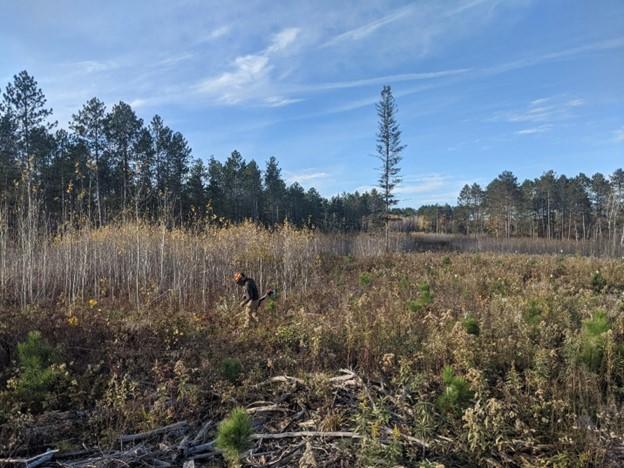Overview
This FDn33 (northern dry-mesic mixed woodland) ecological community had a mature mixed-age conifer-hardwood canopy that was showing signs of decadence. I wanted to capture the timber volume and create growing space for a new cohort. The extant canopy diversity and the mix of soils across the stand suggested that this was a good stand for promoting compositional and structural diversity, both of which are valuable building blocks of ecological and economic resilience to climate and market changes.
Silviculture Objective
Regenerate a new cohort of trees while promoting diversified composition and structure for economic and ecological resilience by using a clearcut-with-reserves silvicultural system with a mix of natural and artificial regeneration strategies. To plan for diversity, I used a combination of the Climate Change Field Guide and MN DNR tree suitability table to select a range of species suited to growing in an FDn33 community; see the Minnesota-specific Climate Change Response Framework for these and other resources.
Pre-treatment stand description and condition
Stand establishment and management history
The pre-treatment stand was cruised during the fall of 2016. Three cohorts were present, though the latter two cohorts represented the majority of the tree density. The oldest cohort included a few large diameter red and white pines with crown structure and fire scars that suggest 1830-50s origin. These few trees were reserved as seed trees during the 1910 pine cutover. A mix of pines, aspen, and paper birch regenerated following the 1910 cutover; most of the red pine and white spruce in the stand in 2017 were in this cohort. In 1946, a timber harvest calling for clearcutting jack pine, aspen, and paper birch was conducted across most of the stand, creating regeneration opportunities for aspen, paper birch, and red maple.
Pre-treatment species composition
The overstory was comprised of a mix of primarily red pines (45% of BA), both trembling and big-toothed aspen (25% of BA), and white spruce (12% of BA). White pine, jack pine, paper birch, red maple, and balsam fir were also present. The understory composition contained a range of densities of beaked hazelnut. Coarse woody debris of various decay classes was observed during the cruise.
Pre-treatment growth and stocking
Pre-harvest average basal area per acre was 153 ft2/ac (see Figure 1). The pre-harvest volume per acre was 48.6 cords per acre (see Figure 2). There were 192 trees per acre on average across the stand.
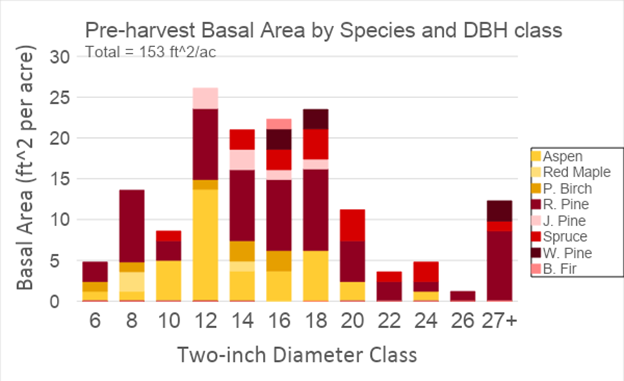
Figure 1: Pre-harvest diameter distribution of basal area per acre by species and two-inch diameter class. Diameters measured at breast height.
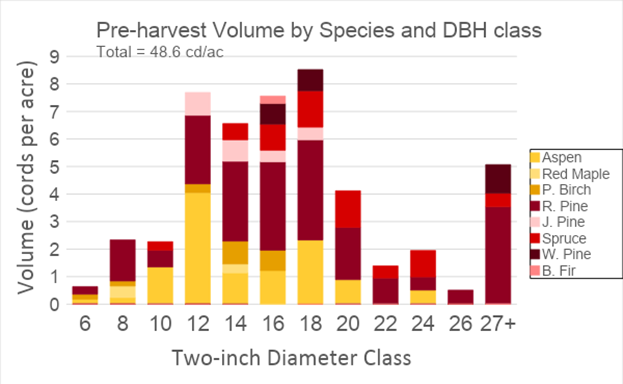
Figure 2: Pre-harvest diameter distribution of volume per acre in cords by species and two-inch diameter class. Diameters measured at breast height.
Pre-treatment forest health issues
The only issue of note was that porcupines had been impacting the large pine and some of the small balsam fir. Deer-herbivory will be a consideration during regeneration
Silviculture prescription
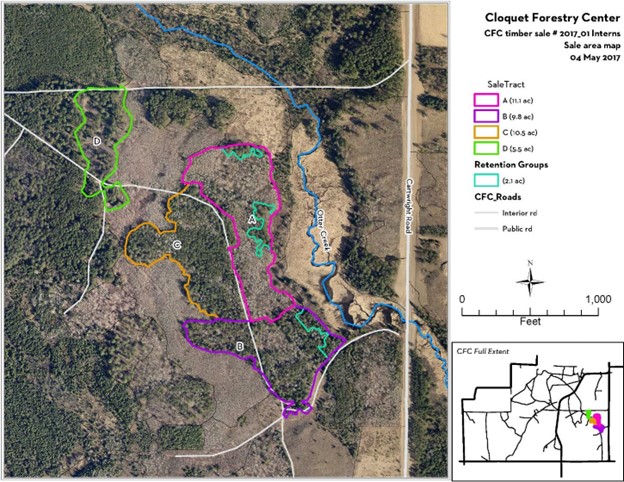
Figure 3: Harvest record 2017_01 sale area map. The FDn33 mixedwood case study stand is Tract B
Harvest
Outside of the conifer retention group on the east side of the stand, the prescription called for clearcutting all species other than white spruce and non-merchantable white pine to retain vertical structure and seed sources. Trees inside the retention group will be marked by the seller to no less than 80 ft2/ac basal area. This will serve as a filter strip for Otter Creek, a designated trout stream. The harvest occurred during May of 2017.
Regeneration
A mix of natural and artificial regeneration strategies were used for eight of the 11 tree species expected to occur in FDn33 ecological communities (see Table 1; www.forestadaptation.org/MN_Resources). The prescription called for a growing season operation with full-tree skidding to passively scarify the soil surface and prepare a mineral soil seedbed for by-seed regeneration.
Table 1: Regeneration types and sources used for each tree species listed in the MN DNR tree suitability rankings for FDn33 communities.
Species | Regeneration type | Source | Tree suitability ranking |
Red pine | Planted 1-0 containerized stock | UPM Blandin/PRT | 1 |
Paper birch | Natural | Stump sprouts and adjacent stand seed | 2 |
White pine | Planted 1-0 containerized stock | UPM Blandin/PRT | 3 |
Quaking & big-toothed aspen | Natural | Root sprouts | 4 & 7 |
Jack pine | Not planned for | 5 | |
Balsam fir | Not planned for | 6 | |
Red maple | Natural | Stump sprouts and adjacent stand seed | 8 |
Black spruce | Not planned for | 9 | |
White spruce | Natural and planted 1-0 containerized stock | UPM Blandin Improved/PRT | 10 |
Northern red oak | Planted 5-12” bare root | MN DNR Badoura Nursery | 11 |
The planting plan called for planting red and white pine, white spruce, and northern red oak across a total of 7.7 of the 10 acres; we did not plant into the conifer retention group. We planted three blocks with different densities because there was no recommended planting density for a mixedwood of this species mix. It was thought that using different densities improved resilience to not knowing an ideal planting density and that the planted species may respond differently to the different densities. See Table 2 and Figure 4 for planting block details. A total of around 6164 seedlings were planted by an operational planting crew on May 27, 2018. The cost was $0.13 per seedling; this was one of three plantings conducted that day.
Table 2: Planting block spacings and densities
Planting block | Spacing (ft) | Density (seedlings/acre) |
A | 11 x 11 | 360 |
B | 7 x 8 | 778 |
C | 5 x 7 | 1245 |
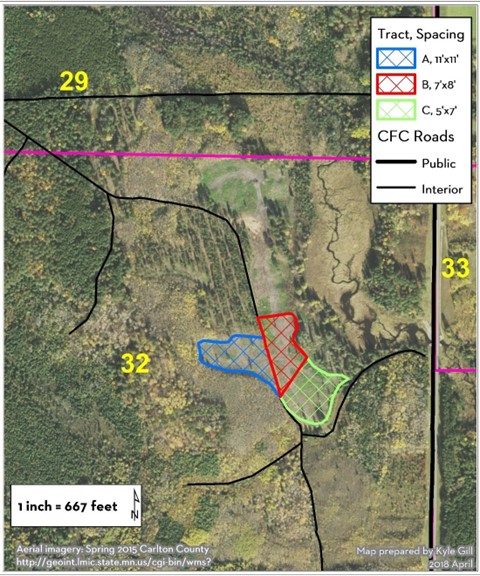
Figure 4: Spring 2018 planting map with three planting blocks identified.
Herbivory prevention
We planned for individual seedling herbivory prevention on the two pine species and the northern red oaks until they were above browse height. We used budcapping on the terminal bud of the pines from 2018-2021 (see Fig 5). In 2018 and 2019, we used light balloons on the terminal bud of the red oaks (see Fig 6). In 2020 we decided to stop capping the red oaks because I decided that we would knock back the oaks to their root collar during the pre-commercial thinning. We did not feel the need to protect the white spruce.
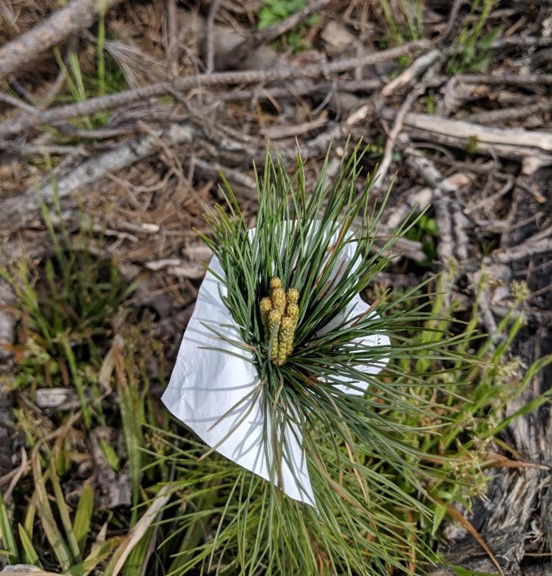
Figure 5: White pine buds growing through a budcap in spring 2019.
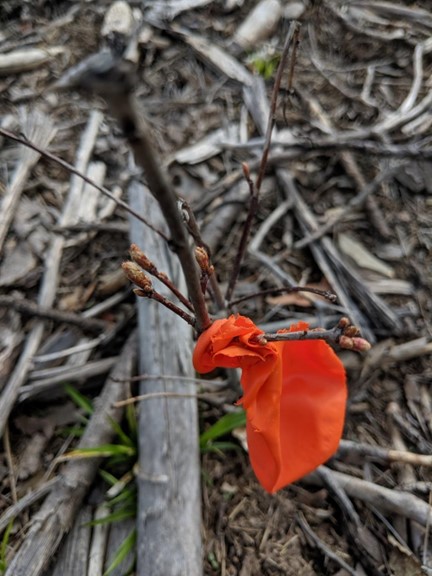
Figure 6: Red oak shoots growing through a balloon in spring 2019. The balloon started to break down over the first winter/spring.
Competition reduction/seedling release treatment
We planned to conduct a competition reduction release treatment (release) between three and five seasons following planting. Initially, we were planning to follow the three-to-four-foot radius release plan that is often used in aspen-spruce mixedwood prescriptions. In the fall of 2020, three growing seasons after planting, we initiated the release but snow prevented us from continuing. In the fall of 2021, we conducted the release (see Figure 7). We increased the release radius to a minimum of six feet to increase light availability around seedlings for two reasons. First, the aspen regeneration was vigorous and we felt the larger radius would help to keep the aspen from dominating the composition. Some of the aspen were already 10-12 feet tall with DBHs of up to 2.5 inches. Second, we recognized that the shade tolerance of the pines and red oak were lower than white spruce so would benefit from additional light and growing space. We used Stihl FS-460 brush saws to conduct the release.
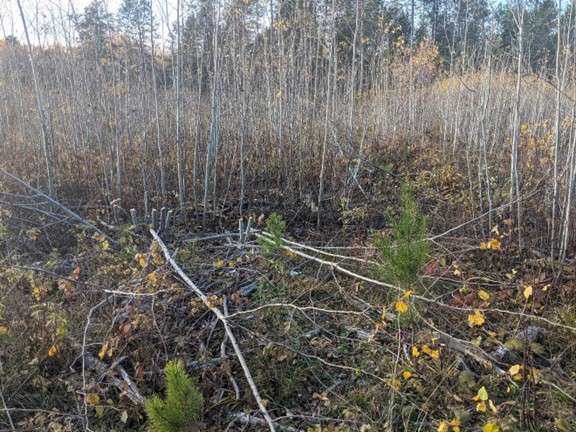
Figure 7: Pine seedlings following release treatment in Fall 2021. Red leaves of red oaks are partially visible among the low foliage and cut stems.
During the release, we also cut the red oak seedlings back to their root collar. The goal for cutting back to the root collar was to induce the tap root to express itself above ground as a relatively vigorous single stem. If we had been conducting a red oak seed tree or shelterwood system we would have planned for the overwood removal treatment to knock back the aboveground oak growth and competition. However, we used a clearcut system and did not want to negatively impact the conifer regeneration. The brush saw cutting mimicked the aboveground effects of using heavy machinery without disturbing conifers.
What happened during the treatment
The harvest and planting treatments went as planned; the harvest was conducted in May 2017, the planting in May 2018, and release completed in the fall of 2021, four growing seasons following planting. The release treatment radius was enlarged to at least six feet from three-to-four feet. Conventional harvesting equipment was used for the harvest (feller-buncher, grapple skidder, delimber, and slasher). A commercial planting crew planted the seedlings. The release was conducted by CFC staff using Stihl FD-460 brush saws.
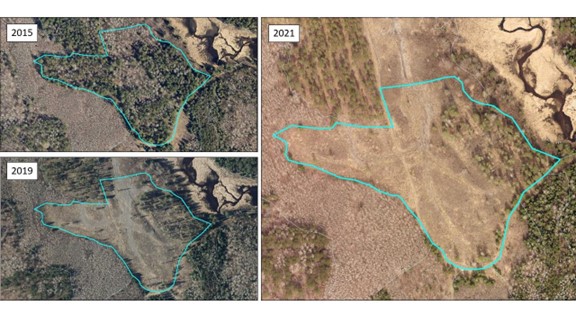
Figure 8: FDn33 Mixedwood case study stand boundary over Carlton County imagery from 2015, 2019, and 2021. The white spruce retention group is noticeable on the east side of the stand in both the 2019 and 2021 images. In the 2019 image, shadows identify scattered spruce retention elsewhere.
Post-treatment assessment
Natural regeneration is mostly growing as expected, though aspen has been more vigorous than expected. Aspen regeneration was already plentiful in the first growing season everywhere except on heavily trafficked skid roads and the delimbing area. No specific slash retention levels were outlined in the harvest specifications. Anecdotally, slash was heaviest on the skid roads and in the delimbing area. A combination of slash and soil compaction is thought to have contributed to the lower aspen regeneration in these areas. Soil compaction is not thought to be a long-term concern due to the sandy soil. Paper birch stump sprouts and scattered seedlings were observed during release treatment. Red maple stump sprouts are vigorous.
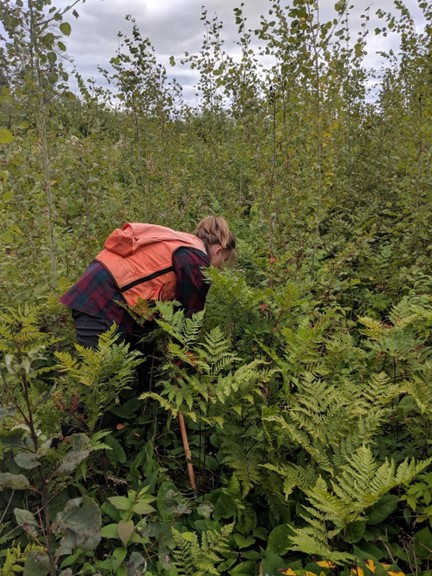
Figure 9: Conducting a regeneration check in August 2019, three growing seasons after harvest and two after planting.
As of 2021, four growing seasons after harvest, the planted regeneration appears to be doing relatively well across most of the stand. We had a bit of mortality in some areas due to a combination of the very aggressive aspen regeneration and because we waited until year four after planting to complete the release treatment. We probably could have started the release treatment in year two or three after planting. Or, we could have let the stand express itself for two-to-three growing seasons after harvest and used a more aggressive tool, such as a skidsteer with a mulching head, to prepare the stand for planting. The density of planting does not appear to be having any impact on survival and growth at this time; the density of aspen competition appears to the be the biggest factor in survival and growth.
Some of the retained mature white spruce have been impacted by wind and porcupines. Within two years of harvest, some of the trees had been blown over and added to the downed woody debris in the stand. It is presumed that they had not previously been as exposed to west winds. Also, dead tops started appearing in some trees. Upon closer inspection, we noticed that porcupines had been active.
Plans for Future Treatments
I will keep an eye on the stand over the next couple of years while budcapping the pines. I will assess whether another competition release treatment would help ensure tree-level diversity. If so, another hand-treatment would be required. Also, I am very curious to see how the red oaks respond to being cut to the root collar.
After budcapping is complete and any followup competition reduction treatments have been implemented, the stand will be free to grow until stand age 25-30.
Costs and economic considerations
Setting up the sale and laying out the harvest was straightforward. This harvest was linked with three other regeneration and thinning treatment areas across 37 acres. The total revenue generated was $47,153 ($1,274/acre).
Choosing one retention species was easy to write into the treatment and to communicate with the purchaser and operator. This was the first time I had harvested near a designated trout stream so it took me a few minutes to figure out how best to comply with the 165’ filter strip guideline. However, the area of dense spruce basically fell near the 165’ line, as determined in GIS. This brought about the idea to make it a reserve patch. White spruce generated $45 per cord in the sale contract. A rough estimate is that 12-15 cords were retained. This puts the rough value of wood left on the stump at $540 - 675
Planting was likely the highest direct cost at $2527 or $328/acre (7.7 of the ten acres were planted). Individual seedlings ranged from $0.16 – 0.32. We planted roughly 1541 seedlings of each of the four species. Planting cost per seedling was $0.13 for the operational crew of eight men. This cost per seedling might a bit higher than larger contracts because the planting was relatively small and the spacing was relatively finicky.
Roughly 20-30 person-hours were put into the brushcutting release treatment. We did this in-house with salaried staff members. This means that the cost per acre was roughly $500 – 750 or $65-$97/acre.
Climate adaptation considerations
Building resilience into forests through structural and compositional diversity is a promoted climate adaptation strategy and at the heart of this treatment. I used the Climate Change Field Guide for Northern Minnesota Forests and the MN DNR tree suitability table to make regeneration decisions. I decided to promote regeneration from across the tree suitability table’s rankings (see Table 1) to ensure compositional diversity. The species from which I did not expect consistent natural regeneration I decided to plant. This climate adaptation strategy also contributes to ensuring economic resilience for this stand.
Lessons learned / additional thoughts
This stand is nearly free to grow. Once it is, it will be assessed at stand age 30, 2048, for a first commercial thinning.
Three primary lessons have been learned through this case study.
- The tools exist for regenerating within-stand tree diversity but the tools for longer-term mixedwood treatments are limited
- A six-foot or larger release radius may be necessary to reduce competition around shade-intolerant species
- Robust aspen regeneration is a both a benefit and a challenge for diversity
Submitted by
Kyle Gill
Kyle has been the CFC forest manager and research coordinator since 2015. He enjoys exploring stand development, silviculture, and the inherent biases that we bring to decision making. He feels it is important to see himself and other humans as community members of forested and non-forested ecological communities.
